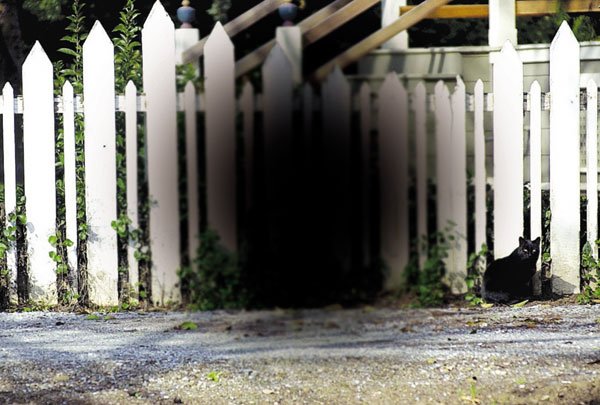An overdue trip to the eye doctor sparks a little self-doubt
I remember this feeling. It’s exactly the feeling I had when I took the SATs in high school. I answer the questions, but I always doubt my answers. Am I answering correctly? If I totally screw up, how dire are the consequences?
This is a typical trip to the eye doctor for me. And this innate fear of “incorrectly” answering questions – such as “Can you read the bottom line?” or “Which line is clearer, the top or the bottom?” – is probably why I haven’t been to an optometrist in years. I’m slightly nearsighted, which means every now and then I have to squint to read street signs or see other far-away objects more clearly. I have a pair of glasses whose prescription was updated about three years ago, which is roughly when I had my last eye exam.
But I recently braved a visit to Dr. Bob Theaker at the Hollister Vision Center, and I turned the tables by asking him and his staff questions to demystify visits to the eye doctor.
My visit began in a little room with three machines placed next to each other on the table. I put my chin on the white plastic chin rest and looked at a little house in the center of a screen. Gonzalez told me that all I had to do was stare at it. Easy enough. While I stared, this machine took detailed photographs of my eyes, said Elisa Gonzalez, a technician at the center. This test was performed to help gauge my prescription.
At the second machine, I again aligned my head on the chin rest. This contraption was apparently going to send a puff of air at my eye to test for glaucoma, Gonzalez said. I don’t know what I was expecting, but when the burst of air came, I jerked backwards about 3 feet and looked accusingly at Gonzalez.
“I know it can be startling, but try and hold still when the air comes,” she said.
Even though I knew what to expect the second time and steeled myself for the air, I still flinched and pulled back from the machine when it puffed into my eye.
“Because glaucoma is caused by fluid building up and increasing the pressure inside the eye, this test helps us look at how much pressure is in the eye,” Dr. Nhu Ehu of Advanced Eye Care in Gilroy told me later. “The cornea, which is the part of the eye you would put your contact over, is actually pliable. The air causes an indentation, and a laser measures the indentation. The depth of the indentation helps us know how much pressure is in the eye. This test doesn’t diagnose glaucoma, but it is part of the diagnosis and also checks how glaucoma treatment is working.”
The third machine was a little bit like playing a video game – a welcome change to having bursts of air shot into my eye. All I had to do was look at a fixed point and click a button whenever squiggly lines appeared in my peripheral vision. This test was to check for bad peripheral vision, which can be a sign of glaucoma.
And then it was time for the “test questions.” I moved to a bigger room that housed the eye charts and all of the heavy-duty equipment.
We began with the well-known eye-chart test. I read the smallest line on the chart, first with my left eye, then with my right. When I looked at the line with both eyes, I saw that I had read some of the letters incorrectly. The SAT-style fear started to set in.
I looked at charts of circles and told the doctor which one appeared as though it were floating in 3-D. There were times I couldn’t tell which circle was floating, and instead of guessing, I told Theaker I wasn’t sure. I snuck glances at his face to check if he wore some sort of look that said “what a sad case” or “boy, did she blow that test.” But he was unreadable.
I then followed a ruler with my eyes as Theaker watched how my eyes moved.
Next I did a battery of tests with a big contraption that looks as though it would be at home on a nuclear submarine – the big, black machine with lenses attached. I looked at one line of letters, and took note of how blurry or clear the letters were. Theaker then switched the sets of letters, and asked me whether the first set or the second set was clearer and more defined. This also was to help determine my prescription.
It started out easy. But after a few repetitions, I had to ask to see the preceding set of letters again. The difference was so slight that I couldn’t tell which set was less blurry. Sometimes both lines of letters looked pretty clear. Other times, they were both so blurry, I couldn’t see any change.
The doctor occasionally had to remind me to tell him which set of letters looked more defined, not necessarily just darker and therefore easier to read. He recommended that I look at the Bs and the Ds rather than the Cs or Hs, because it’s easier to see how blurry those letters were.
When my test anxiety got the best of me, I asked Theaker how I was doing. To my surprise, he said very well.
“We do this so many times to get the most accurate idea of your prescription as possible,” he explained. “The more times we do this, the better the picture we get of how your eyes are working.”
The questions were over, and one of the last things I had to do was stare off into the distance as Theaker got up close and personal with my eyes using a bright blue light. He instructed me to continue staring ahead as he moved the light close to my eye. He was checking that my retina and the inside of my eyes were healthy. A more in-depth exam would have included pupil dilation, but that would have meant it would be a few hours before my pupils had readjusted and could function normally. My editors wouldn’t have been happy if I couldn’t see anything at work.
The final part of my eye exam involved using my glasses. Theaker told me my right eye had changed since I had received the prescription for my glasses, so he had me look through a different pair of glasses that were adjusted to those changes. Things suddenly came into much sharper focus.
In the end, the whole experience was pretty painless. Even having air puffed into my eyes was much less invasive than my regular dentist checkups, and I keep those appointments religiously. I’ll certainly be more diligent about my eye appointments from now on. After all, early detection is the key to resolving most eye problems.
Have you seen your optometrist lately?
The Shape of Your Eyes
Nearsightedness is when objects close to you are seen clearly, but objects far away are blurry or do not come into proper focus. This is caused when the eye is too long.
Farsightedness is when objects far from you are seen clearly, but objects close to you are blurry or do not come into proper focus. This is caused when the eye is too short.
Astigmatism is a condition in which light entering the eye is unable to be brought into a single focus, resulting in blurred vision at all distances. This is not a disease and is quite common. It is caused when the cornea, which is the part of the eye a contact would go over, is shaped more like an oval or like a football, instead of shaped round or like a basketball. Astigmatism doesn’t allow the light to focus properly, but the condition is easily treated with glasses.
Source: American Optometric Association
Healthy Eyes Are Happy Eyes
Mother always said eating carrots is good for the eyes. Turns out she was right – almost.
Eating vegetables really can help your eyes stay healthy, but leafy greens are better than carrots. The antioxidants and vitamins in these vegetables are good for your eyes, but be careful that you don’t overcook them and lose most of the nutritional value.
Also be aware of how often you’re using over-the-counter eye drops. Dry or red eyes may be signs of more serious conditions. If your eyes are affected by allergies or hay fever, prescription drops may be more helpful than over-the-counter drops. Consuming flaxseed oil or fish oils helps keep eyes moisturized, and artificial tears, rather than Visine, are best for keeping eyes moist.
Source: Dr. Nhu Ehu of Advanced Eye Care, Gilroy
Two Reasons to Make an Appointment Today
1. Glaucoma: This eye disease occurs when passages in the eye that allow fluid to drain get clogged. When fluid builds up within the eye, so does the pressure, leading to blurred vision or a gradual loss of peripheral vision. The earlier that glaucoma is detected, the more effectively it can be treated.
2. Macular degeneration: This is the leading cause of vision loss among people older than 50. Macular degeneration happens when macula, a part of the retina, begins to thin and stops functioning properly, or when newly formed blood vessels leak under the macula and cause vision loss. Degeneration can sometimes be treated with laser therapy, but early detection is key. Macular degeneration causes a distorted dark spot, often in the center of vision. The spot grows bigger as degeneration continues.
Left untreated, either condition can lead to total blindness.
Source: American Optometric Association















